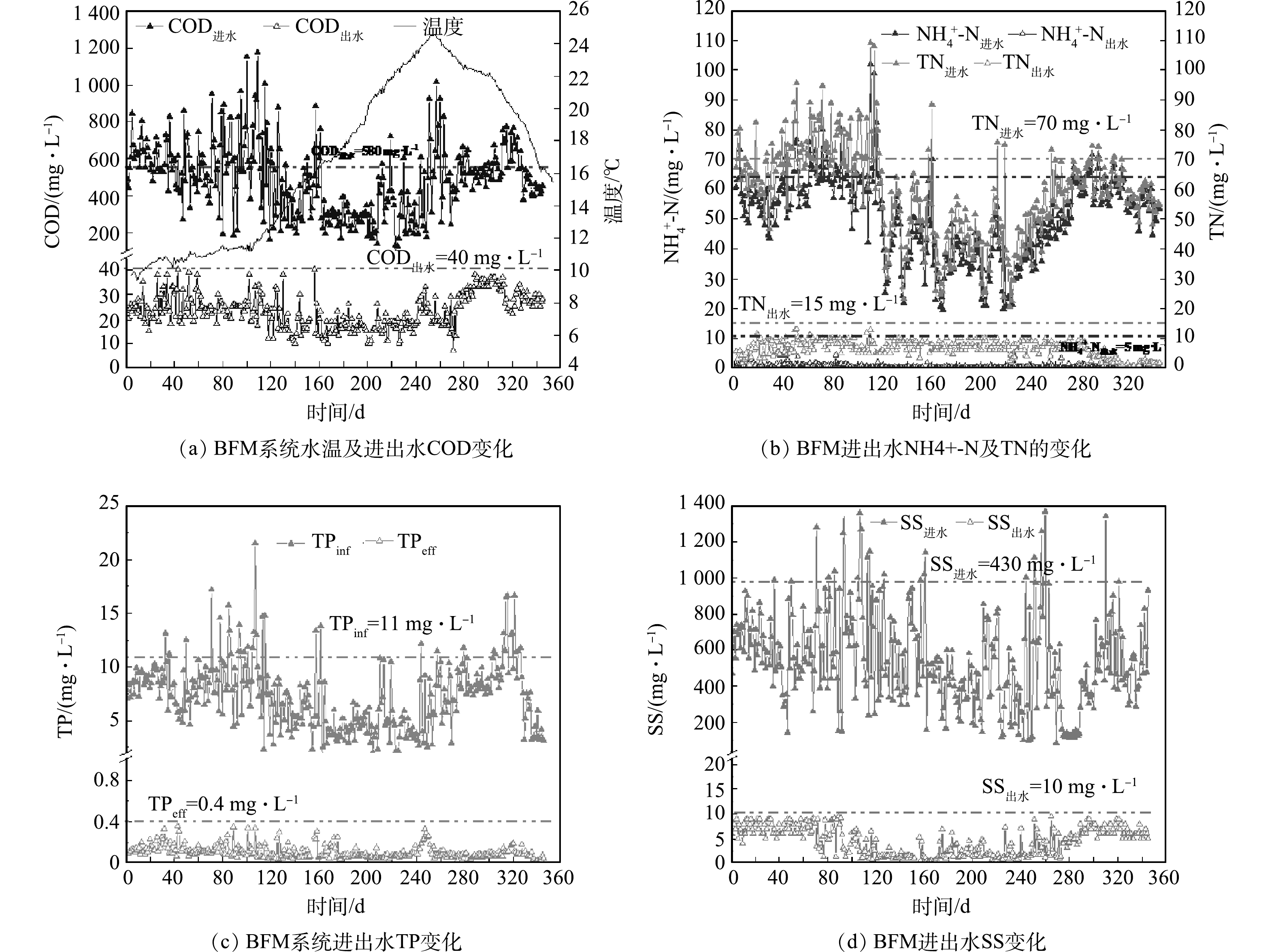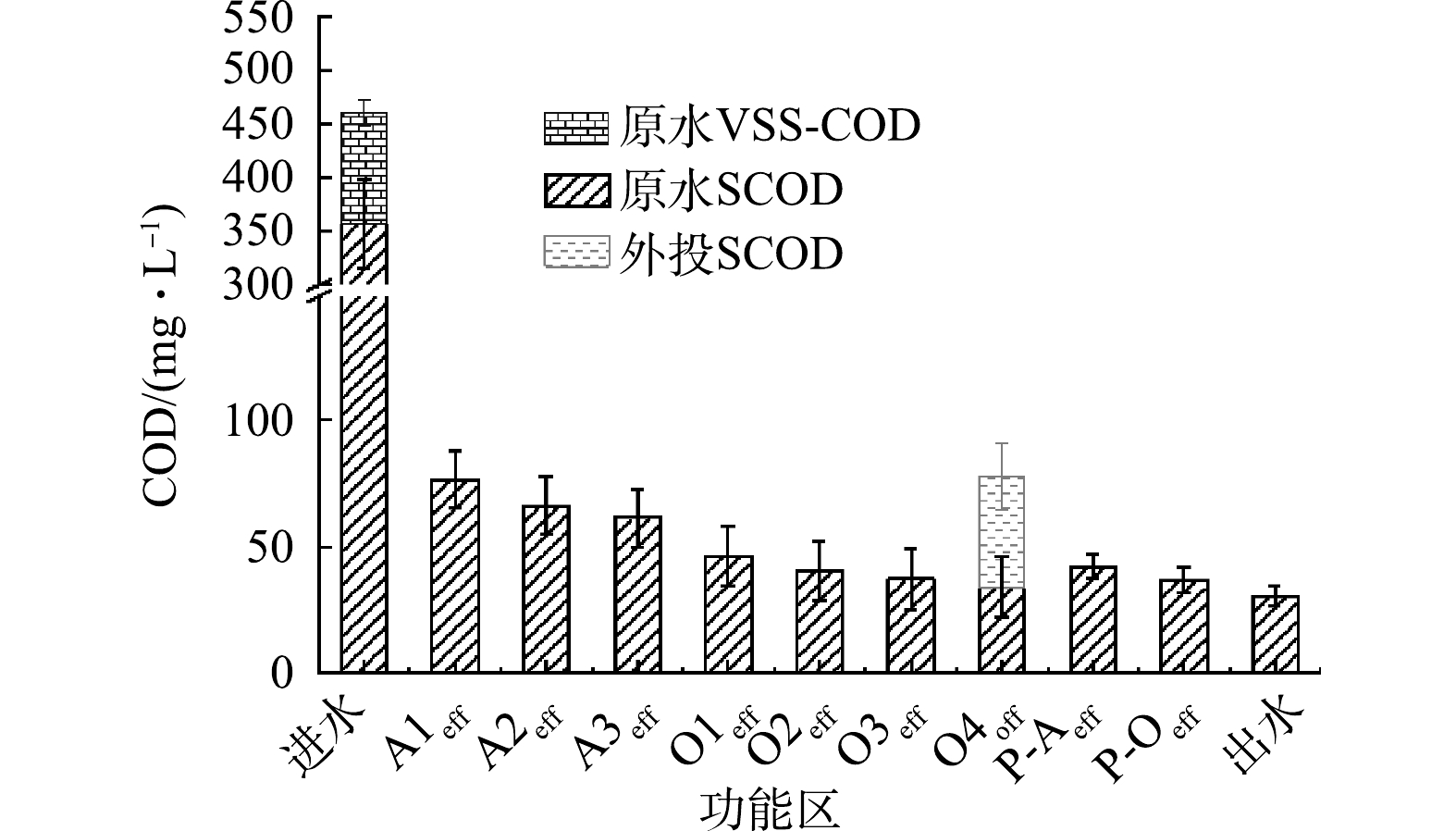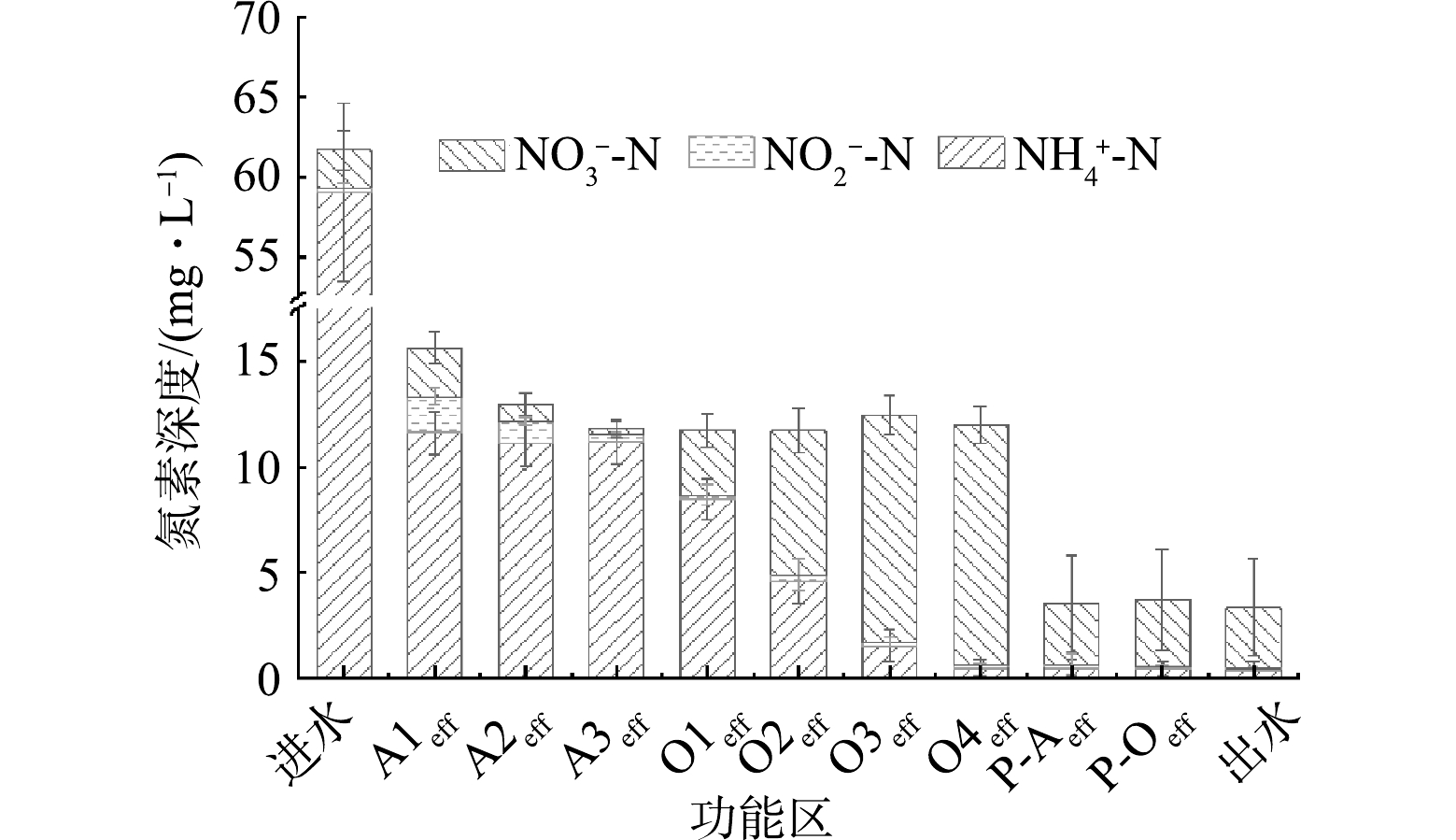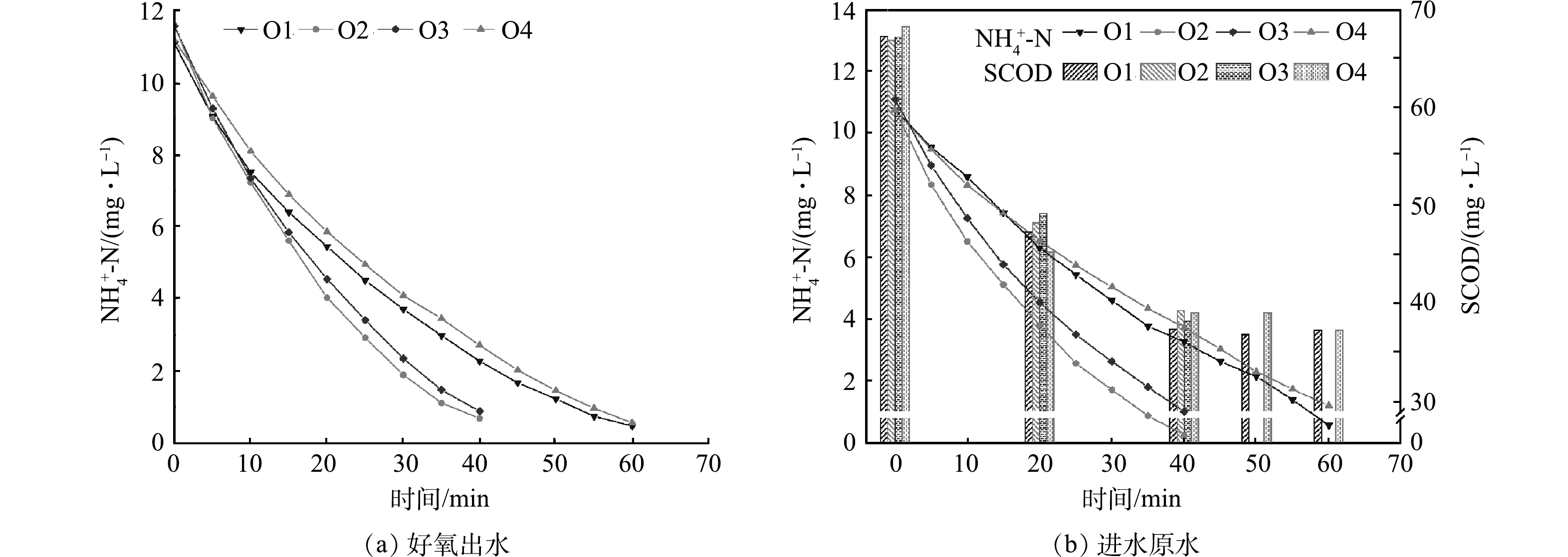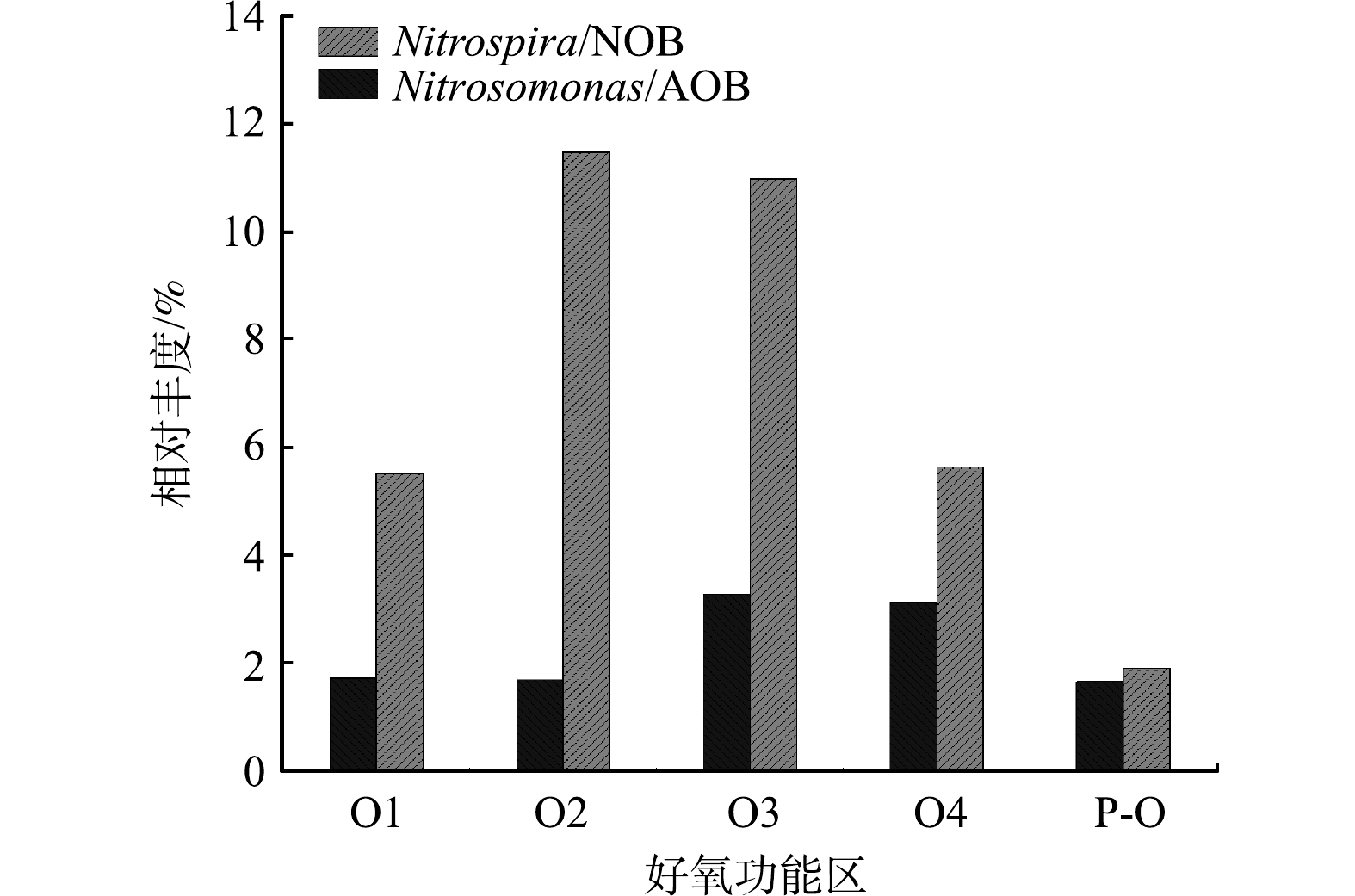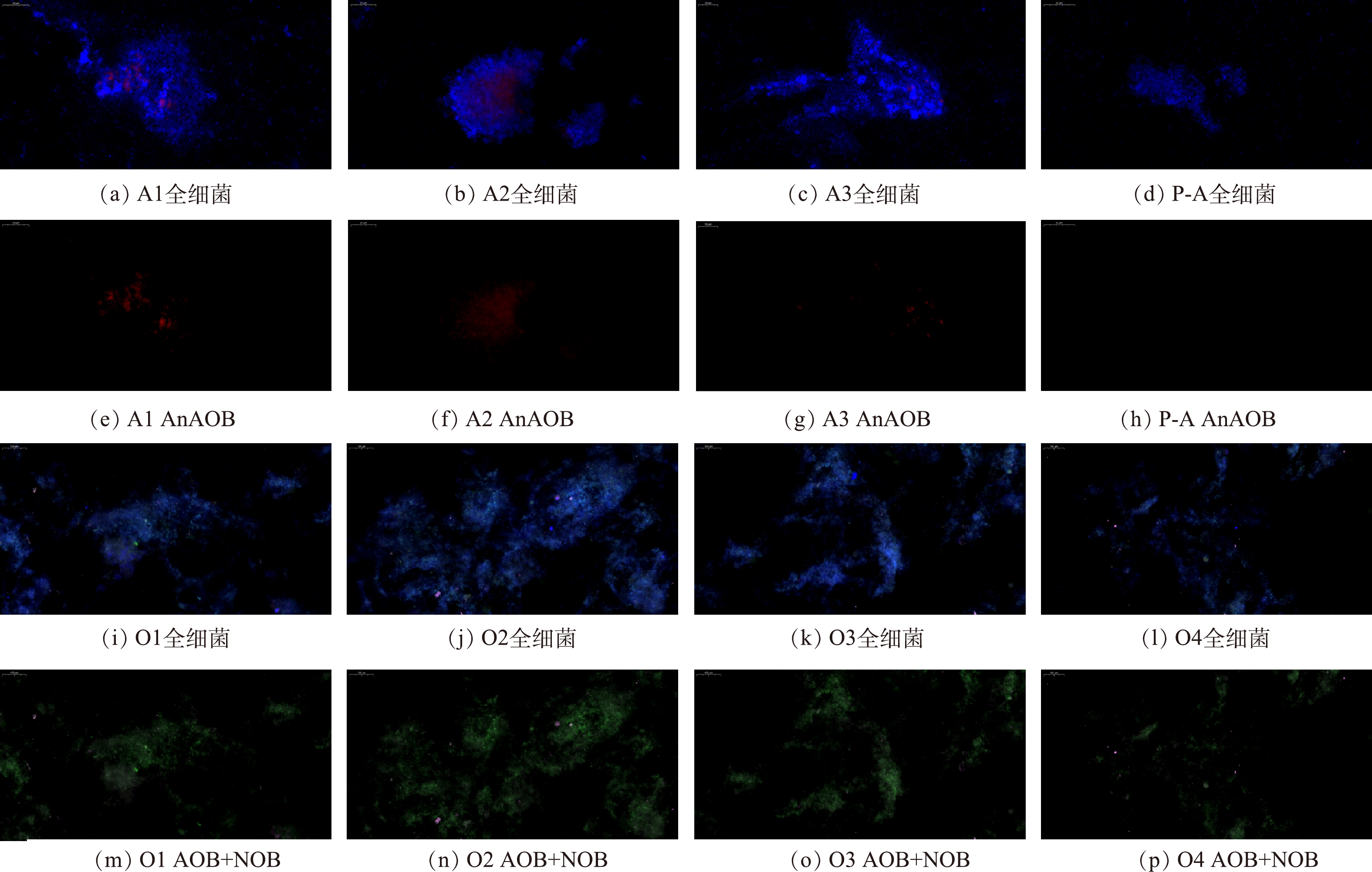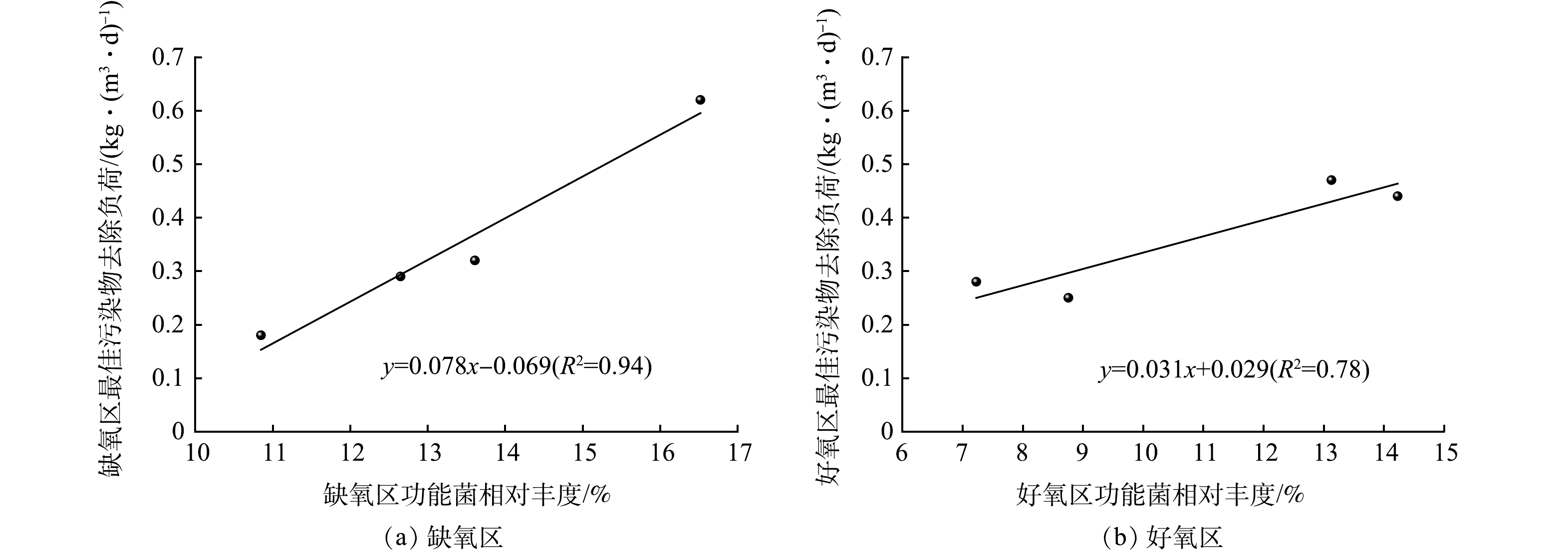-
移动床生物膜反应器(moving bed biofilm reactor,MBBR)根据微生物相存在形式,分为泥膜复合MBBR和纯膜MBBR工艺2种形式。在21世纪初期,针对国内污水厂提标改造,采用泥膜复合MBBR工艺一定程度上解决了污水厂提标改造面临的需新增占地及运行不稳定等难题,从而得到了大范围应用。有研究[1]表明,泥膜复合MBBR系统中泥膜两相存在的泥膜竞争关系导致生物膜潜力无法充分发挥,而纯膜MBBR不再富集活性污泥,摆脱了泥膜竞争关系,能够进一步提高生物膜处理能力。
纯膜MBBR处理效果与工艺流程密切相关,采用分段A/O设置优势较为明显,如前段A/O可利用原水碳源脱氮,后段则利用外投碳源脱氮,以破除传统A2/O工艺中总氮(total nitrogen,TN)去除受回流比限制的约束,进而提高系统整体脱氮效率,满足国内对于出水TN需进一步降低的需求。此外,通过单一功能区的分级也使得每级生物系统都能获得互不干扰、功能相对独立的生境,更利于发挥MBBR工艺定向培养、专性富集的特点,分别培养特定功能的微生物种群,可进一步提升MBBR系统处理效果[2-3]。相关研究表明,王雪欣等[4]采用两点进水三段纯膜A/O-MBBR中试处理北方生活污水,前2段A/O在缺氧和好氧均设置2级工艺,且设置单独的进水点和硝化液回流,第3段A/O在缺氧和好氧均设置单级工艺,系统出水SCOD、NH4+-N可优于类IV类水标准。周小琳等[5]采用两段纯膜A/O-MBBR中试处理北方某城市污水,第1段A/O中,缺氧设置为两级,采用原水碳源脱氮,好氧设置为3级;第2段A/O中,缺氧设置为两级,采用外投碳源脱氮,好氧设置为一级,系统出水SCOD、NH4+-N同样可优于类IV类水标准。刘婧邈[6]采用两段式A/O-纯膜MBBR进行污水脱氮,各功能区通过专性富集形成独特的菌群结构,在污水处理过程中联合作用,保证出水水质稳定达标。ZHOU等[7]建立了一种有效容积为10 m3的新型的两点进水三段A/O纯膜MBBR中试系统,用于城市污水处理,进水点分别设置于1段和2段A/O缺氧区,第1和第2段A/O均设置自好氧向缺氧的硝化液回流,且均为两级工艺,三段A/O均为单级工艺,在HRT仅为10 h的基础上,系统中TN去除率高达91.42%。可见,纯膜MBBR工艺采用多段分级的设置,确实可以达到较好的处理效果。但目前,关于纯膜MBBR相关研究仍存在一定缺陷。首先,纯膜MBRR技术的研究和尝试多局限于中试阶段,缺乏大体量工程应用;其次,纯膜MBRR中试采用分段多级的布置形式,但这种布置形式仍没有具体可靠的依据参考,脱氮机理还有待研究;最后,目前虽已确定纯膜MBBR能进行功能菌群的专性富集,但关于各级功能菌群的分布特征还缺乏针对性研究。因此,本文以多级多段纯膜MBBR工艺处理国内北方某污水厂中高基质浓度市政污水的工程项目为研究对象,通过工程宏观运行情况结合微观菌群结构,分析了纯膜MBBR脱氮机理及分级合理性,为后续纯膜MBBR工艺的多级多段设计及工程应用提供参考。
-
北方某污水处理厂设计处理量12×104 m3·d−1,主体采用基于活性污泥法的改良A2/O工艺,为缓解长期满负荷运行压力,于2021年采用BFM(moving biofilm & magnetic separation,悬浮载体生物膜-磁分离高效处理工艺)技术[8]新建1×104 m3·d−1的污水处理设施,对污水厂进水实现分流处理。BFM生物段为纯膜MBBR工艺,实现主要碳氮污染物的去除,固液分离段为改良磁加载沉淀,实现主要总磷(total phosphorus,TP)及悬浮固体(suspended solids,SS)的充分去除,从而保证出水全指标达标。如图1所示,新建项目总用地1 417.25 m2,核算吨水占地面积为0.14 m2·(m3·d)−1,仅为现有污水处理厂活性污泥法占地的17.00%。新建项目设计进出水水质如表1所示,设计水温10 ℃,出水COD、TP等指标需达到《地表水环境质量标准》(GB 3838-2002)V类水标准,氨氮满足冬季低于5 mg·L−1,夏季低于3 mg·L−1,TN需达到《城镇污水处理厂污染物排放标准》 (GB 18918-2002) 一级A标准。
新建项目工艺流程如图2所示,预处理段采用原污水厂初沉池及自清洗过滤器进行颗粒物去除,后进入纯膜MBBR段,纯膜MBBR采用两段A/O工艺流程,其中前缺氧(前A)分三级(A1-A2-A3),主好氧(前O)分四级(O1-O2-O3-O4),后缺氧(post anoxia,P-A)和后好氧(post aerobic,P-O)均为单级工艺,在O4与A1之间设有硝化液回流管路,控制回流比300%~400%。前缺氧利用原水碳源进行脱氮,后缺氧设置碳源投加管路,按照去除8~10 mg·L−1的NO3−-N,以ΔCOD/ΔNO3−-N为6,投加乙酸钠(25%有效COD含量)实现TN的高标准去除。纯膜MBBR缺氧区悬浮载体填充率均为50%,主好氧区悬浮载体填充率60%,后好氧区悬浮载体填充率为50%。纯膜MBBR出水进入改良磁加载沉淀段进行泥水分离,投加聚合氯化铝 (PAC,8% Al2O3有效成分) 及阴离子PAM进行化学除磷。系统总水力停留时间(hydraulic retention time,HRT)10.6 h,其中纯膜MBBR段HRT为10.35 h,纯膜MBBR前缺氧3.45 h,主好氧4.60 h,后缺氧和后好氧均为1.15 h,改良磁加载沉淀池HRT为0.25 h。
-
于2022年9月19日—2022年11月29日对系统沿程各池体进行水质检测,取样点分别为纯膜MBBR段进水、纯膜MBBR段各级出水、改良磁加载沉淀段出水,取混合样按已有方法[9]分别测定各样品NH4+-N、NO2−-N、NO3−-N、TN、TP、溶解性COD (Soluble COD,SCOD) 等指标。污染物去除负荷按照式(1)计算。
式中:N为污染物去除负荷,即单位池容每天所能去除的污染物质量,kg·(m3·d)−1;△A为污染物质量浓度变化量,mg·L−1,t为反应时间,h。
于研究结束时(2022年11月29日),采集纯膜MBBR段各级悬浮载体样品,进行基于16SrDNA的扩增子高通量测序,此时悬浮载体生物膜菌群组成更能代表研究期间情况,高通量测序选用试剂盒(E.Z.N.A Mag-Bind Soil DNA Kit,OMEGA) 提取微生物基因组DNA,通过1%琼脂糖凝胶电泳检测抽提基因组的完整性,利用Qubit3.0 DNA试剂盒测定基因组DNA质量浓度。PCR 扩增所用引物为341F/805R。对PCR产物进行琼脂糖凝胶电泳,并通过DNA 胶回收试剂盒(SanPrep)对PCR产物进行回收,利用Qubit3.0 DNA检测试剂盒对回收的DNA 精确定量,按照1:1的等量混合后测序;通过Illumina Miseq 测序平台完成对样品的高通量测序,测序序列已提交至NCBI(BioProject ID:PRJNA955194)。测序结果中有关物种组成参考已有方法进行分析[10-11]。FISH实验采用表2所示序列及标记物合成荧光探针,对于缺氧区,主要关注厌氧氨氧化菌,对于好氧区,则主要关注硝化菌。
-
为验证各功能区悬浮载体在进水水质升高时的抗冲击负荷能力,进行悬浮载体最大负荷验证小试实验。搭建有效容积为16 L的小试系统,硝化小试采用纯膜MBBR主好氧段各级生物膜,同步考虑进水SCOD影响,设置2组实验,一组采用纯膜MBBR系统A3出水模拟实际好氧区进水,另一组采用纯膜MBBR系统O1出水,以降低缺氧池出水所含SCOD影响,2组小试均通过投加氯化铵和碳酸氢钠补充氨氮及碱度至合适质量浓度后作为小试用水,实验过程中控制小试系统水温和DO与实际纯膜MBBR系统一致。反硝化小试采用前缺氧各级生物膜和后缺氧生物膜,同步考虑进水碳源类型影响,设置两组实验,一组实验采用原水和O4出水按照实际平均回流比混合之后作为小试用水。另一组采用O4出水,以降低原水碳源影响,且通过投加乙酸钠补充碳源至合适质量浓度后作为小试用水,两种水质均通过投加硝酸钾补充硝氮至合适质量浓度,实验过程中控制小试系统水温与实际纯膜MBBR系统一致。
-
BFM项目设计HRT为10.6 h,根据表3统计,该项目HRT仅为相同地区类似水质采用活性污泥法污水厂的43%~56%。在工艺流程上,BFM仅通过两段工艺即可实现出水稳定达标,无需传统活性污泥法所需的二沉池和深度处理,工艺流程更短,也减少了所需附属设备设施。综合HRT和附属设备构筑物,BFM节地效果突出。
项目启动成功后,纯膜MBBR各池体悬浮载体挂膜情况如图3所示。在生物膜颜色上,缺氧区载体生物膜颜色呈现棕黄色,好氧区生物膜颜色呈现深棕色,在生物膜厚度上,好氧区生物膜厚度较缺氧区更厚,前AO生物膜厚度相对后AO更厚,单一功能区从前往后生物膜厚度逐渐变薄。
近一年项目实际进水水量达到(9 148.59±591.55) m3·d−1,核算系统总HRT为(11.60±0.76) h,其中纯膜MBBR段HRT为(11.32±0.74) h,接近设计值。项目水温变化幅度较大,夏季可达20 ℃以上,冬季可至10 ℃以下。新建项目实际进出水水质如图4所示,进水COD、NH4+-N、TN、TP及SS分别为(487.60±193.86)、(50.65±13.80)、(58.59±15.51)、(7.29±3.13)和(571.00±250.59) mg·L−1,进水水质波动较大,且存在明显高于设计进水水质标准的现象,各污染物超标率(超标天数/总运行天数)分别达到28.65%、56.43%、21.64%、10.53%和69.59%,但经处理后,对应出水COD、NH4+-N、TN、TP及SS依然能够降至(23.15±7.05)、(0.54±0.67)、(6.59±2.77)、(0.11±0.06)和(4.46±2.76) mg·L−1,稳定达到设计标准。且在后期(2022年10月3日-2022年11月29日)通过提高碳源投加量对纯膜MBBR段运行优化后,出水TN可进一步降至(2.31±1.52) mg·L−1,稳定低于5 mg·L−1,充分体现了系统强大的脱氮潜力。此外,随着温度的降低,以及进水水质的波动,出水水质始终保持在排放标准内,表明系统具有较强的抗低温能力,保障出水水质稳定达标。
纯膜MBBR可在HRT仅为活性污泥法约50%的基础上,实现稳定的处理效果,且对进水水质间歇超标具有较强的抗冲击能力。基于纯膜MBBR的BFM技术能够实现污水厂建设用地的大幅度节省,国内首座BFM项目于2020年在广东肇庆落地,该项目BFM占地仅为《城市污水处理工程项目建设标准》(建标〔2001〕77 号)的最低要求的4%。实际吨水占地约为常规污水处理厂的10%~25%[17];北方首座BFM项目吨水占地指标为原厂活性污泥工艺的26%[18];而本项目采用BFM吨水占地仅为原厂活性污泥系统的17%。
-
通过污染物沿程变化分析氮素去除路径。2022年9月19日—2022年11月29日,系统水温为(19.80±2.34) ℃。由于系统HRT短,对于不溶性物质的利用效率较低,因此,仅考虑可溶性物质的利用。沿程SCOD去除效果如图5所示,进水中SCOD和不溶性COD(VSS-COD)值分别为(356.61±41.83) mg·L−1和(103.95±12.35) mg·L−1,按照实际回流比核算前缺氧A1实际进水SCOD值为(102.39±11.36) mg·L−1,出水SCOD降至(71.89±11.43) mg·L−1,经A2和A3处理后,SCOD值分别降至(59.19±11.51) mg·L−1和(53.26±11.45) mg·L−1。经过主好氧区后,SCOD值进一步降至(34.16±11.84) mg·L−1,主好氧区SCOD去除主要依赖于O1,O1出水SCOD值已降至(43.38±10.26) mg·L−1,核算占好氧区SCOD去除的(51.73±7.07)%。后缺氧外投乙酸钠进行反硝化脱氮,核算SCOD投加值为(43.49±13.34) mg·L−1,导致其出水SCOD值微升至(42.11±4.77) mg·L−1,但经后好氧和改良磁加载沉淀深度处理后,SCOD值进一步降至(36.79±5.22) mg·L−1和(30.56±4.20) mg·L−1,稳定达到排放标准。
从沿程SCOD去除效果看,前缺氧存在SCOD未完全利用的现象,致使好氧区一级发生了较为明显的脱碳效果,但经过好氧一级之后,SCOD去除效果明显下降,此后降低的SCOD可认为是较难降解的有机物。由于后缺氧主要依靠外投碳源进行脱氮,因此,认为原水所携带SCOD经前A/O已消耗殆尽,核算A1~A3及前O的原水SCOD去除贡献率均值分别为44.70%、18.61%、8.69%、27.99%,后缺氧区通过外投碳源,在实现TN去除的前提下,也存在少量的SCOD未利用现象,而后好氧区的设置,可针对未利用的SCOD进行针对性去除。改良磁加载沉淀通过投加絮凝和混凝药剂,可进一步去除(6.23±2.29) mg·L−1的SCOD。周小琳等[5]利用两段式A/O-MBBR工艺生物脱氮中试处理青岛某污水厂一级处理出水,前A设置两级工艺,合计HRT为2.8 h,SCOD去除贡献率达到64.60%。本研究在前缺氧A1-A2合计HRT为2.3h,SCOD去除贡献率达到63.61%,与其差异不大。
系统沿程氮素去除效果如图6所示,进水NH4+-N和TIN质量浓度分别为(59.00±5.62)、(61.37±5.82) mg·L−1,按照实际回流比核算前缺氧区进水NH4+-N和NOx−-N(硝态氮,取NO3−-N和NO2−-N加和)质量浓度分别为(12.42±1.04)、(9.58±0.64) mg·L−1,经A1~A3处理后,出水NOx−-N质量浓度分别降至(3.98±0.77)、(1.84±0.52)和(0.64±0.47) mg·L−1,前缺氧区出现了一定程度的NH4+-N下降及NO2−-N积累现象,至A3出水,NH4+-N质量浓度略降至(11.16±0.99) mg·L−1,结合回流比,核算前缺氧区共去除了(4.20±1.03) mg·L−1的NH4+-N。至A1~A3出水,系统中NO2−-N质量浓度分别达到(1.01±0.31)、(0.66±0.18)、(0.38±0.08) mg·L−1。好氧区主要发生硝化反应,经过O1~O4后,NH4+-N质量浓度分别降至(9.13±1.08)、(5.25±1.03)、(1.41±0.62)、(0.51±0.37) mg·L−1。伴随着NH4+-N的硝化,NOx−-N随之上升,至O4出水,NOx−-N质量浓度升至(11.46±0.88) mg·L−1,好氧区NO2−-N积累量明显降低,O1出水NO2−-N质量浓度为(0.22±0.45) mg·L−1,至O4出水,NO2−-N质量浓度降至(0.09±0.10) mg·L−1。后缺氧通过外投碳源的方式,将NOx−-N质量浓度进一步降至(3.06±2.30) mg·L−1,至后缺氧结束至改良磁加载沉淀出水,系统氮素变化不再明显,最终出水NH4+-N和NOx−-N质量浓度分别为(0.40±0.38) mg·L−1和(2.94±2.31) mg·L−1。
从沿程TIN去除效果看,前缺氧A1~A3脱氮负荷分别为(0.53±0.09)、(0.20±0.07)、(0.10±0.03) kg·(m3·d)−1,脱氮贡献率均值分别为52.27%、19.96%和11.20%。脱氮效率降低的原因一方面与NO3−-N质量浓度随推流下降,生物膜传质梯度弱化有关,另一方面也与碳源可生化性下降有关。但该项目前缺氧合计脱氮贡献率达到83.43%,较周小琳研究结果(48.2%)提高近1倍。原因一方面可能与本项目进水COD更高,提供的原水碳源更多有关,另一方面也与本项目前缺氧设置三级工艺并使HRT进一步延长有关。结合沿程SCOD变化,核算A1~A3的ΔSCOD/ΔNOx−-N分别为5.15±0.36、5.23±0.11和5.57±0.28,脱氮所需C/N逐渐升高,意味着易生物降解的高质量碳源逐渐减少。后缺氧区脱氮负荷0.16±0.05 kg·(m3·d)−1,ΔSCOD/ΔNOx−-N为4.04±1.55,脱氮贡献率均值为16.57%。相比前缺氧区,采用外投碳源进行反硝化的后缺氧区具有更高的脱氮效率,但由于碳源投加量较低,限制了其负荷的发挥,这也为应对进水冲击时,出水TN稳定达标奠定了基础。至于前缺氧区NH4+-N下降及NO2−-N积累的原因猜测为发生了厌氧氨氧化现象。根据NO2−-N来源的2种可能,一种可能是前缺氧区产生了短程反硝化现象,将NO3−-N转化为NO2−-N,另一种则是由于硝化液回流携带溶解氧,导致在缺氧区产生了短程硝化,将NH4+-N转化为NO2−-N。本研究采用蒸馏水作为小试实验进水,以排除有机物影响,以氯化铵和硝酸钾补充NH4+-N和NO3−-N至BFM前缺氧区实际进水质量浓度一致,以BFM前缺氧区A1悬浮载体进行反硝化小试,通过缺氧搅拌控制系统DO与BFM缺氧区A1一致,实验过程中未发现明显的NH4+-N氧化及NO2−-N积累现象,因此,确定系统中的NO2−-N主要来源于短程反硝化过程。主好氧O1~O4硝化负荷分别为(0.23±0.04)、(0.40±0.10)、(0.39±0.09)、(0.11±0.08) kg·(m3·d)−1,硝化贡献率均值分别为23.04%、33.11%和25.94%、8.79%,O1和O4分别受前缺氧COD剩余和基质过低影响,导致硝化负荷偏低。后好氧区硝化贡献率仅为0.03%,与硝化效果相关性不大。根据周小琳等实验结果[5],纯膜MBBR系统主好氧区氨氮去除负荷随进水SCOD的升高而呈明显下降趋势,因此,为保证主好氧区硝化效果,前缺氧A3的设置仍然起到一定的有益效果,可降低直接进入主好氧气区的SCOD值。
综上所述,在脱氮方面,纯膜MBBR脱氮的主要承担者在于前缺氧A1~A2,两者合计脱氮贡献率超过75%。A3的设置则可进一步降低进入主好氧区的SCOD值,虽然该工况下仍然存在部分SCOD未完全利用,但由于出水硝氮已经降至1 mg·L−1以下,而继续上调回流比会导致回流液所含DO过多影响原水碳源利用,因此,并无延长HRT及设置四级的必要。从硝化的角度,主要承担者在于主好氧区O1~O3,三者合计硝化贡献率超过80%。O3出水氨氮已降至设计出水标准之下,若要达到更严格的出水标准,则可考虑增设四级工艺。P-A可以通过外投碳源的方式,弥补原水碳源不足缺陷,实现TN的进一步去除。而P-O的设置则主要针对P-A过量的外投碳源,保证出水COD的稳定达标,不具备硝化效果。
-
硝化小试结果如图7所示,以NH4+-N下降速率明显降低的时间点认为硝化效果受基质限制,硝化负荷以初始NH4+-N和基质受限之前的NH4+-N质量浓度变化进行核算。当采用O1出水作为小试进水时,主好氧区各级硝化负荷依次为0.28、0.47、0.44和0.25 kg·(m3·d)−1,对比BFM工程中主好氧区各级实际硝化负荷均值分别为0.23、0.40、0.39、0.11 kg·(m3·d)−1,各级小试硝化负荷分别提升至工程的1.22、1.17、1.13、2.27倍。而采用A3出水时,各好氧功能区负荷分别为0.25、0.42、0.41和0.23 kg·(m3·d)−1,各级小试硝化负荷分别提升至工程的1.09、1.05、1.05、2.09倍,略低于采用O1出水时的小试负荷。
小试中基质的升高会提升其他好氧各级硝化效果,且工程中的硝化负荷越小,高基质下的负荷提升效果越明显。瞬时的基质提升能够快速提高负荷,说明悬浮载体生物膜中存在一定基数的功能菌群,在正常条件下,生物膜仅表层功能菌发挥作用,当受进水基质冲击时,生物膜传质梯度升高时,内层生物膜上富集的功能菌可以发挥处理潜力,提高处理效率,这也是纯膜MBBR系统具有较强抗冲击能力,保持出水氨氮稳定达标的主要原因。前缺氧区由于存在部分未降解完全的SCOD,导致实际运行中O1硝化效果不佳,而采用A3出水进行小试时发现瞬时的SCOD升高会对各级悬浮载体硝化负荷均造成抑制,抑制率(由于SCOD升高导致的硝化负荷下降比例)在6.80%~10.64%。所以在实际运行时,应注意在前缺氧区尽可能充分利用原水碳源,防止过多SCOD进入好氧区抑制硝化效果。对于本项目,O1的设置去除了绝大部分进入主好氧区的可生化SCOD,保证了O2~O4的硝化环境。另外,从小试SCOD与NH4+-N的变化趋势可以看出,纯膜MBBR系统SCOD和NH4+-N同步去除,不同于活性污泥法先降COD再降NH4+-N的分步去除[18],表明纯膜MBBR能够一定程度上减弱COD的硝化抑制程度。
反硝化小试结果如图8所示,以NO3−-N下降速率明显降低的时间点认为脱氮效果受基质限制,脱氮负荷以初始NO3−-N和基质受限之前的质量浓度变化进行核算。当采用原水碳源时,A1~A3及P-A脱氮负荷依次分别为0.62、0.32、0.18和0.14 kg·(m3·d)−1,消耗的C/N分别为5.17、5.59、5.73和5.61,对比纯膜MBBR工程各缺氧区实际脱氮负荷均值分别为0.53、0.20、0.10、0.16 kg·(m3·d)−1,前缺氧区各级小试脱氮负荷分别提升至系统实际运行负荷的1.17、1.60、1.80倍。而在原水碳源下,P-A小试负荷出现降低,为系统实际运行负荷的0.88倍。采用外投碳源时,各缺氧区对应脱氮负荷分别升至1.27、0.55、0.31和0.29 kg·(m3·d) -1,达到实际运行的2.40、2.75、3.10、1.81倍,是采用原水碳源的2.05、1.72、1.72、2.07倍,脱氮消耗的C/N分别降至4.56、4.66、5.13和4.56。
当采用原水碳源时,在碳源与硝氮基质充足时,前缺氧各级悬浮载体脱氮负荷均较系统实际运行得到提升,且与硝化一致,工程中脱氮负荷越小,高基质下的负荷提升效果越明显。原因也与生物膜传质梯度有关,基质的升高使生物膜处理潜力进一步得到释放。而P-A由于在实际运行时采用外投碳源的方式,小试采用原水碳源出现负荷降低的原因主要与原水碳源利用效率更低有关。采用外投碳源时,由于含有更多易生物降解的优质碳源,较小试原水碳源具有更强的可利用性,有利于促进反硝化速率,致使缺氧各级悬浮载体脱氮负荷均出现更大幅提升,且提升效果远高于原水碳源,说明当进水TN负荷超标或原水碳源不足时,临时通过外投碳源的方式可以显著提升系统脱氮负荷,提高系统抗冲击性,保证出水氮素稳定达标。而P-A在外投碳源条件下小试负荷高于工程实际运行的原因则主要与硝氮和碳源质量浓度更高有关,强化了生物膜传质效果,进而增强了脱氮效率。
纯膜MBBR系统在进水冲击时可以显著提升污染物去除负荷,但受限于各级HRT较短,在冲击时仍存在基质在不同分级之间穿透的情况,从而使系统中各级悬浮载体生物膜都富集一定基数的功能菌,当实际运行面临进水冲击时,生物膜传质梯度增加,可以使前期富集的功能菌得到利用,进一步释放生物膜处理潜力,提高系统抗冲击性,保证出水稳定达标。为保证硝化效果,应在实际运行时尽可能在前缺氧区将原水碳源利用殆尽,为保证脱氮效果,在面临大幅度进水冲击时,可以通过临时投加外投碳源的方式,使系统脱氮效率显著提升,以保证出水达标。
-
对纯膜MBBR系统不同分级的脱氮功能菌组成进行分析,对于好氧区,各级生物膜优势硝化菌组成相同,但相对丰度存在差异。如图9所示,优势硝化菌属包括Nitrosomonas (亚硝化单胞菌) 和Nitrospira (硝化螺旋菌) 。其中,Nitrosomonas为亚硝化菌(ammonia oxidizing bacteria ,AOB),能够将NH4+-N氧化为NO3−-N,在O1~O3及P-O中相对丰度分别为1.73%、1.69%、3.27%、3.11%和1.65%。Nitrospira为NOB(亚硝酸盐氧化菌),将NO2−-N氧化为NO3−-N,部分菌属也具备直接将氨氮氧化为硝酸盐氮的能力[19-20],其在O1~O4及P-O中的相对丰度分别为5.50%、11.44%、10.96%、5.65%和1.91%,因此,纯膜MBBR系统O1~O3及P-O中硝化菌合计相对丰度分别可达7.23%、13.13%、14.23%、8.76%、3.56%。ZHOU等[21]通过研究两级AO纯膜MBBR工艺生物膜微生物多样性时发现,生物膜中硝化菌主要菌属Nitrosomonas和Nitrospira在前好氧2级中相对丰度同样高于一级,可能也与前缺氧区出水存在部分未利用的有机物导致对好氧一级硝化效果造成了一定抑制导致。
高晨晨等[22]研究表明,在长三角和华北地区9座城市污水处理厂中,活性污泥中硝化菌同样为Nitrosomonas和Nitrospira,但两者相对丰度均值合计仅为3.27%。有研究[23]表明,在与本项目距离及水质相近的青岛某污水厂活性污泥系统中,AOB与NOB相对丰度合计仅为1.58%。而同样位于青岛的某污水厂活性污泥系统中,AOB与NOB在半年内合计相对丰度仅为0.33%~0.96%[7]。可见对于活性污泥法,不同项目受具体水质及运行条件影响,硝化菌相对丰度并不相同,纯膜MBBR工艺中硝化菌类型与活性污泥法较为相似,但主要硝化区硝化菌相对丰度显著高于活性污泥法。
通过伯杰细菌鉴定手册[24]及相关文献描述的具有普遍脱氮属性的菌属作为脱氮菌。缺氧区脱氮菌组成如图10所示。其中优势脱氮菌属主要包括Denitratisoma、Flavobacterium、Hyphomicrobium、Terrimonas、Rhodobacter等,DNB_others为相对丰度低于1%的脱氮菌相对丰度加和。Denitratisoma为革兰氏阴性反硝化菌,能够利用不同类型的碳源进行反硝化,根据生长环境差异,其反硝化产物包括N2O、N2等多种形式。该菌属在A1~A3及P-A中相对丰度逐渐由6.14%降至1.69%,分析原因主要有两点,首先,其相对丰度下降与基质质量浓度逐渐降低有关;其次,前后缺氧虽然碳源类型不同,但该菌属在P-A中基质充足的基础上仍维持在较低丰度,表明其或许更适合利用原水大分子有机碳源进行脱氮。Flavobacterium为常见异养反硝化菌,属于拟杆菌门,能降解羟基丁酸戊酸共聚酯(PHBV)。在低氧或无氧条件下,能利用NO3−-N或NO2−-N作为最终电子受体进行无氧呼吸,同时具备将多种大分子有机物转化为小分子有机物的能力[25-26],该菌属在不同缺氧区相对丰度维持在1.43%~2.60%,无明显变化,其对不同碳源的利用能力可能相似。Hyphomicrobium属于变形菌门,可利用有毒难降解有机物进行反硝化脱氮,如二氯甲烷、甲胺磷、二甲基硫醚和甲醇等,还可参与多环芳烃(polycyclic aromatic hydrocarbons,PAHs)污染水体中菲的降解[27-28]。该菌属在前缺氧区中相对丰度逐渐由4.62%降至2.13%,在后缺氧区中则升至3.12%,其相对丰度与脱氮负荷呈明显正相关,该菌属的出现及较高的相对丰度或许说明了进水中含有部分难降解有毒物质。Terrimonas属于拟杆菌门,部分菌种属于严格好氧化能异养菌,不仅能够进行好氧反硝化,还可以参与蒽类物质,包括苯并芘和布洛芬的降解[29-30]。该菌属在前缺氧区中的相对丰度逐渐由3.67%降至1.31%,而在P-A中则升至5.29%,说明该菌属更容易利用乙酸钠等小分子有机碳源进行反硝化脱氮,但同时也能进行原水中大分子有机物的降解。Rhodobacter为兼性厌氧菌,属于变形菌门,在污水处理系统中较为常见,多可通过光合作用进行获得能量,进行自养或异养生长,具有较为显著的代谢多样性。该菌属在A1~A3及P-A中相对丰度维持在2.71%~5.68%,但无明显变化规律。综合来看,脱氮菌在A1~A3及P-A中合计合计相对丰度分别达到16.52%、13.61%、10.85%、12.65%,与脱氮效果具有一定正相关性,保障了出水氮素的稳定达标。此外,缺氧区还存在Candidatus Brocadia类型厌氧氨氧化菌,在A1和A2中的相对丰度分别达到1.25%和1.53%,该菌属能够在缺氧条件下利用NH4+-N和NO2−-N反应生成N2,实现自养脱氮[31],一方面能够强化系统TN去除,另一方面能够弥补进水碳源的不足,减少外投碳源量。厌氧氨氧化菌的存在也也为前缺氧氨氮去除提供了微观支撑。该项目中发现的厌氧氨氧化菌属与西安第四污水处理厂缺氧区悬浮载体生物膜中发现的主要厌氧氨氧化菌类型一致,但相对丰度较之(0.043%)提高了30倍以上[32],NEJIDAT等[33]研究了城市污水处理厂高碳氮比下不同隔间内的厌氧氨氧化菌的丰度和多样性,结果表示,高碳氮比的主流城市污水处理厂中,厌氧氨氧化菌优势菌属同样为Candidatus Brocadia,说明其相比其他厌氧氨氧化菌属更能适应城市污水高碳氮比水质环境。至于厌氧氨氧化菌所需基质NO2−-N的来源,则可能是在较低的进水C/N下,结合纯膜MBBR较低的HRT[34],为短程反硝化的发生提供了条件,也为厌氧氨氧化脱氮提供了基质。
纯膜MBBR系统FISH检测结果如图11所示,对于缺氧区,在A1和A2中同样检测出厌氧氨氧化菌(红色部分)的存在,而在A3和P-A中则含量很少。对于好氧区,O1~O3中硝化菌(绿色+浅红色)含量较高,而O4中硝化菌含量明显降低。另外,同高通量测序结果类似,系统中硝化菌主要为NOB,而AOB含量很少。整体上,FISH检测结果与高通量测序结果较为一致。
纯膜MBBR各主要功能区悬浮载体功能菌相对丰度及最大污染物去除负荷如表4所示,对于好氧区,功能菌相对丰度指硝化菌相对丰度(图9),对于缺氧区,功能菌相对丰度指脱氮菌相对丰度(图10)。最大污染物去除负荷指在基质充足条件下且最能反映实际运行效果的小试负荷,对于硝化,则以O1作为进水的小试结果,对于脱氮,则以原水碳源下A1~A3小试负荷及外投碳源下P-A负荷进行表征。整体上,功能菌相对丰度与最大污染物去除负荷呈现正相关关系。另外,在工程运行中污染物去除效果不明显的A3与O4,既有污染物去除负荷也有一定的功能菌相对丰度,验证了实际运行时,存在水质基质穿透从而为功能菌的富集提供了条件。
TORRESI等[35]通过三级纯膜MBBR反硝化研究,观察到几种药物的去除率与相关反硝化基因的丰度呈正相关,但与生物多样性无关。本研究对缺氧区和好氧区污染物最大去除负荷与功能菌相对丰度之间进行线性拟合,结果如图12所示。缺氧区和好氧区污染物最大去除负荷与功能菌相对丰度之间呈显著正相关。可见,纯膜MBBR高效处理效果的前提为功能菌群的强化富集,通过线性拟合方程结合高通量测序结果,可以近似得到各功能区最佳污染物去除负荷,从而为工程中系统的抗冲击负荷能力提供数据参考。
-
1)纯膜MBBR耦合改良磁加载沉淀工艺具有更高的污染物去除负荷,HRT可节省约50%,基于纯膜MBBR的BFM工艺在进水水质间歇超标的前提下仍能实现稳定的处理效果,抗冲击负荷能力强。
2)采用前缺氧3级、主好氧4级、后缺氧和后好氧均为单级的多段分级A/O设置,纯膜MBBR系统氨氮去除率超过80%发生在O1~O3,系统TN去除率超过75%发生在前缺氧A1~A2,O4和A3的设计提高了系统的抗冲击负荷能力。
3)纯膜MBBR优势硝化菌为Nitrospira和Nitrosomonas,在主好氧区相对丰度分别达到3.50%~6.91%和0.65%~2.28%,优势反硝化菌属(Denitratisoma、Flavobacterium、Hyphomicrobium、Terrimonas和Rhodobacter等)的合计相对丰度10.85%~16.52%。纯膜MBBR在前缺氧区提高了Candidatus Brocadia型厌氧氨氧化菌富集效率,相对丰度达到1.21%~1.56%,为主流厌氧氨氧化的稳定实现提供依据。
4)纯膜MBBR缺氧区与好氧区不同分级之间,最大污染物去除负荷与功能菌相对丰度均呈现正相关性,并分别满足y=0.078x-0.069(R2=0.94)和y=0.031x+0.029(R2=0.78)。纯膜MBBR通过多级多段设计,优化脱氮路径,充分发挥MBBR处理优势,具备节地效果好,抗冲击能力高等优势。
多级多段纯膜MBBR工艺的脱氮稳定性与微生物菌落结构分析
Analysis of denitrification stability and microbial structure in multi-stage pure MBBR process
-
摘要: 采用宏观运行、原位小试及微观群落组成相结合的方式,探究了多级多段的纯膜MBBR工艺在工程应用中的脱氮效果及脱氮路径。结果表明,纯膜MBBR耦合改良磁加载沉淀工艺的HRT相比传统活性污泥工艺可缩短50%,且脱氮稳定性强。建议纯膜MBBR采用两级AO设计,并根据出水标准及进水波动情况,前缺氧和主好氧区分别设置2级以上以及2~4级工艺。在实际运行面临水质冲击时,通过生物膜传质梯度增加,可以显著提升污染物去除负荷,保证脱氮稳定性。在水质冲击幅度过大时,可以通过临时投加外投碳源的方式保证出水氮素稳定达标。纯膜MBBR优势硝化菌Nitrospira和Nitrosomonas,在主好氧区相对丰度分别达到3.50%~6.91%和0.65%~2.28%。Denitratisoma、Flavobacterium、Hyphomicrobium、Terrimonas和Rhodobacter等优势反硝化菌属的合计相对丰度10.85%~16.52%。缺氧区和好氧区污染物最大去除负荷与功能菌相对丰度均呈正相关。纯膜MBBR在前缺氧区提高了Candidatus Brocadia型厌氧氨氧化菌富集效率,相对丰度达到1.21%~1.56%,可为主流厌氧氨氧化的稳定实现提供参考。纯膜MBBR结合多级多段设计,具备节地效果好,抗冲击能力高等优势。Abstract: The performance and path of denitrification in a full-scale engineering of the multi-stage pure moving bed biofilm reactor (MBBR) were explored by the combined approaches of macro-scale operation, in situ small-scale test and micro-observation of microbial community composition. The results showed that compared with that of the traditional activated sludge process, the HRT of pure MBBR coupled with improved magnetic loading sedimentation process was reduced by 50%, and it had strong nitrogen removal stability. It was recommended that the pure MBBR could adopt two-stage AO design. According to the effluent standard and influent fluctuation, the front anoxic zone and the main aerobic zone should be designed with two or more stages and 2~4 stages, respectively. When facing with water quality impact during the actual operation, the pollutant removal load could be raised significantly to guarantee the nitrogen removal stability by increasing the mass transfer gradient of biofilm. When the impact of influent quality is too strong, the nitrogen in the effluent can be guaranteed to meet the standard by temporarily adding external carbon sources. The relative abundances of the dominant nitrifying bacteria Nitrospira and Nitrosomonas in the pure MBBR reached 3.50%~6.91% and 0.65%~2.28% in the main aerobic zone, respectively. The dominant denitrifying bacteria were Denitratisoma, Flavobacterium, Hyphomicrobium, Terrimonas and Rhodobacter, with a total relative abundance of 10.85%~16.52%. There was a positive correlation between the maximum pollutant removal load and the relative abundance of functional bacteria in anoxic and aerobic zones. Pure MBBR improved the enrichment efficiency of Candidatus Brocadia type anammox in the pre-anoxic zone with the relative abundance of 1.21%~1.56%, which can provide a reference for the stable realization of mainstream ANAMMOX. Multi-stage pure MBBR can fully present the advantages of MBBR treatment involving land saving and high impact resistance.
-
Key words:
- moving bed biofilm reactor /
- denitrification /
- staged /
- carbon source type /
- functional bacteria
-
表 1 设计进出水水质
Table 1. Influent and effluent water quality
mg·L−1 进(出)水 COD BOD5 SS TN NH4+-N TP 设计进水 580 260 430 70 50 11 设计出水 40 10 10 15 3 (5) 0.4 表 2 FISH探针序列组成
Table 2. Composition of FISH probe sequence
功能微生物 探针序列 标记物 标记物颜色 全细菌基因组 / dapi 蓝色 亚硝化菌(AOB) 5'-TATTAGCACATCTTTCGAT-3' CY5 浅红色 厌氧氨氧化菌(AnAOB) 5'-AAAACCCCTCTACTTAGTGCCC-3' CY3 红色 亚硝酸盐氧化菌NOB 5'-GGAATTCCGCGCTCCTCT-3' FAM 绿色 表 3 不同工艺污水处理项目HRT对比
Table 3. HRT comparison among different sewage treatment processes in real projects
表 4 纯膜MBBR各功能段功能菌相对丰度与最大污染物去除负荷
Table 4. Relative abundance of functional bacteria in each zone of pure MBBR and the optimal pollutant removal load
功能区 功能菌相对丰度/% 最大污染物去除负荷/(kg·(m3·d)−1) A1 16.52 0.62 A2 13.61 0.32 A3 10.85 0.18 P-A 12.65 0.29 O1 7.23 0.28 O2 13.13 0.47 O3 14.23 0.44 O4 8.76 0.25 -
[1] 赫俊国, 江伟勋, 何卓义, 等. IFAS工艺处理南方低碳源污水的泥膜微生物互作规律分析[J]. 环境科学, 2022, 43(9): 4736-4747. [2] 美国水环境联合会. 生物膜反应器设计与运行手册[M]. 北京: 中国建筑工业出版社, 2013. [3] 刘智晓. 后置生物膜三级反硝化工艺特性及其应用[J]. 中国给水排水, 2014, 30(20): 46-50. doi: 10.19853/j.zgjsps.1000-4602.2014.20.010 [4] 王雪欣, 毕学军, 麻弛张, 等. 两点进水三段A/O-MBBR生物脱氮中试研究[J]. 中国给水排水, 2021, 37(17): 62-68. [5] 周小琳, 樊星, 毕学军, 等. 两段式A/O-MBBR工艺生物脱氮中试与系统优化[J]. 中国给水排水, 2021, 37(19): 72-77. doi: 10.19853/j.zgjsps.1000-4602.2021.19.012 [6] 刘婧邈. 多段式A/O-纯膜MBBR系统脱氮能力与微生物结构关系研究[D]. 青岛: 青岛理工大学, 2022. [7] ZHOU X, JIANG Z, GU J, et al. Performance characteristics and bacterial community analysis of a novel two-step-feed three-stage A/O-MBBR system for nitrogen removal in municipal wastewater[J]. Journal of Water Process Engineering, 2023, 52: 103513. doi: 10.1016/j.jwpe.2023.103513 [8] 陈祥瑞, 杜强强, 韩文杰, 等. 基于纯膜MBBR的紧凑型污水处理BFM中试基质转化特性[J]. 环境工程学报, 2021, 15(11): 3741-3756. doi: 10.12030/j.cjee.202107149 [9] 水和废水监测分析方法(第四版)[M]. 北京: 中国环境科学出版社, 2002. [10] 韩文杰, 周家中, 刘妍, 等. 纯膜MBBR工艺处理微污染水的工程启动研究[J]. 中国给水排水, 2022, 38(7): 19-27. [11] 韩文杰, 吴迪, 周家中, 等. 长三角地区MBBR泥膜复合污水厂低温季节微生物多样性分析[J]. 环境科学, 2020, 41(11): 5037-5049. doi: 10.13227/j.hjkx.202003327 [12] 秦桂海. 烟台辛安河污水处理厂工程的升级改造[J]. 中国给水排水, 2018, 34(12): 95-97. doi: 10.19853/j.zgjsps.1000-4602.2018.12.022 [13] 韩萍, 许斌, 宋美芹, 等. 团岛污水厂MBBR工艺的升级改造及运行效果[J]. 中国给水排水, 2014, 30(12): 110-114. [14] 韩锡友, 黄子进, 方金强, 等. MBBR应用于污水厂提量改造及其能耗药耗分析[J]. 净水技术, 2021, 40(12): 69-77. [15] 段存礼, 顾瑞环, 程俊涛, 等. 青岛李村河污水厂升级改造工程设计及运行[J]. 中国给水排水, 2011, 27(12): 66-70. doi: 10.19853/j.zgjsps.1000-4602.2011.12.018 [16] 苏鹏, 路晖, 杨永刚, 等. MBBR在卡鲁塞尔氧化沟提标改造中的应用[J]. 中国给水排水, 2020, 36(6): 112-117. doi: 10.19853/j.zgjsps.1000-4602.2020.06.022 [17] 彭明, 周家中, 韩文杰, 等. 基于纯膜MBBR的BioFIMag工艺用于新建污水处理厂[J]. 中国给水排水, 2021, 37(6): 71-75. [18] 周家中, 韩文杰, 宋平周, 等. 华北某集约型污水厂BFM工艺设计与运行分析[J/OL]. 中国给水排水: 1-10[2023-02-01]. http://kns.cnki.net/kcms/detail/12.1073.TU.20220409.1928.002.html [19] DAIMS H, LEBEDEVA E V, PJEVAC P, et al. Complete nitrification by Nitrospira bacteria[J]. Nature, 2015, 5287583: 504-509. [20] 史国帅, 白莉, 周立光, 等. 岸边带生态系统中全程氨氧化细菌以及化螺菌属群落结构的研究[J]. 环境科学学报, 2019, 39: 1-9. [21] ZHOU X, ZHANG Y, LI Z, et al. A novel two-stage anoxic/oxic-moving bed biofilm reactor process for biological nitrogen removal in a full-scale municipal WWTP: Performance and bacterial community analysis[J]. Journal of Water Process Engineering, 2022, 50: 103224. doi: 10.1016/j.jwpe.2022.103224 [22] 高晨晨, 郑兴灿, 游佳, 等. 城市污水脱氮除磷系统的活性污泥菌群结构特征[J]. 中国给水排水, 2015, 31(23): 37-42. doi: 10.19853/j.zgjsps.1000-4602.2015.23.010 [23] 周小琳. 复合铁酶促活性污泥系统低温脱氮机理研究[D]. 青岛: 青岛理工大学, 2014. [24] R. E. 布坎南. 伯杰细菌鉴定手册[M]. 北京: 科学出版社, 1984. [25] JIA S, HAN H, ZHUANG H, et al. The pollutants removal and bacterial community dynamics relationship within a full-scale British Gas/Lurgi coal gasification wastewater treatment using a novel system[J]. Bioresource Technology, 2016, 200: 103-110. doi: 10.1016/j.biortech.2015.10.005 [26] CAO S, DU R, LI B K, et al. High-throughput profiling of microbial community structures in an ANAMMOX-UASB reactor treating high-strength wastewater[J]. Applied Microbiology and Biotechnology, 2016, 100: 6457-6467. doi: 10.1007/s00253-016-7427-6 [27] 李勇. 改良型卡鲁塞尔氧化沟脱氮效能提升及其生物微环境的研究[D]. 重庆: 重庆大学, 2016. [28] 王莉, 凌琪, 伍昌年, 等. Hyphomicrobium sp. MAP-1 菌株修复甲胺磷乙酰甲胺磷和水胺硫磷污染土壤的实验研究[J]. 农业环境科学学报, 2013, 32(1): 81-87. doi: 10.11654/jaes.2013.01.013 [29] POSSELT M, MECHELKE J, RUTERE C, et al. Bacterial diversity controls transformation of wastewater-derived organic contaminants in river-simulating flumes[J]. Environmental Science & Technology, 2020, 54(9): 5467-5479. [30] HUANG S, ZHU Y, ZHANG G, et al. Effects of low-intensity ultrasound on nitrite accumulation and microbial characteristics during partial nitrification[J]. Science of the Total Environment, 2020, 705: 135985. doi: 10.1016/j.scitotenv.2019.135985 [31] DU R, CAO S, ZHANG H, et al. Flexible nitrite supply alternative for mainstream anammox: advances in enhancing process stability[J]. Environmental Science & Technology, 2020, 54(10): 6353-6364. [32] LI J W, PENG Y Z, ZHANG L, et al. Quantify the contribution of anammox for enhanced nitrogen removal through metagenomic analysis and mass balance in an anoxic moving bed biofilm reactor[J]. Water Research, 2019, 160: 178-187. doi: 10.1016/j.watres.2019.05.070 [33] ALI N, DAMIANA D R, NEDAL M, et al. Abundance and diversity of anammox bacteria in a mainstream municipal wastewater treatment plant[J]. Applied Microbiology & Biotechnology, 2018, 102: 1-11. [34] 操沈彬. 基于短程反硝化的厌氧氨氧化脱氮工艺与菌群特性[D]. 哈尔滨: 哈尔滨工业大学, 2018. [35] TORRESI E, GÜLAY A, POLESEL F, et al. Reactor staging influences microbial community composition and diversity of denitrifying MBBRs-implications on pharmaceutical removal[J]. Water Research, 2018, 138: 333-345. doi: 10.1016/j.watres.2018.03.014 -




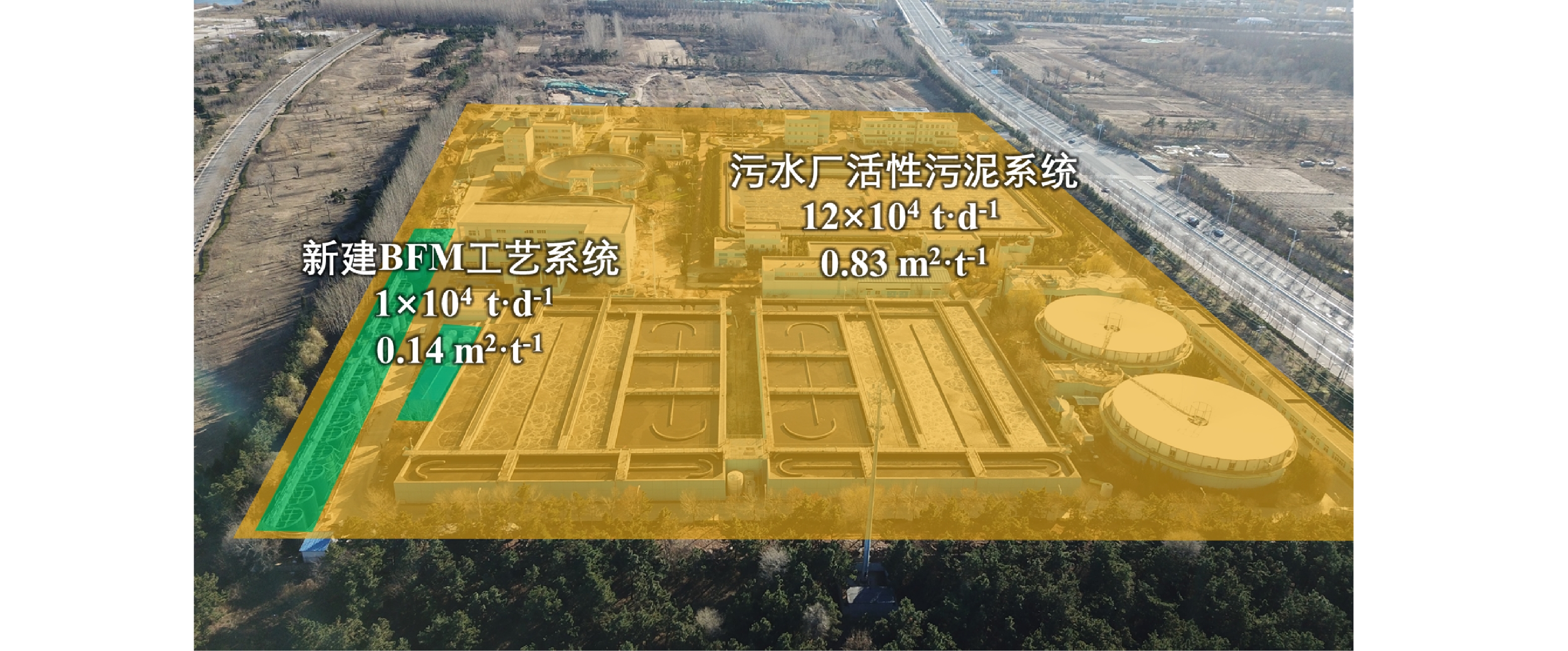
 下载:
下载:


